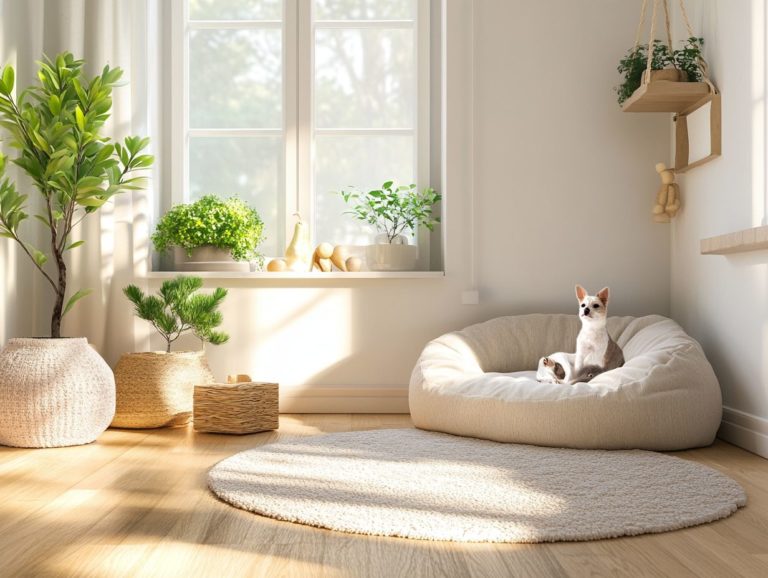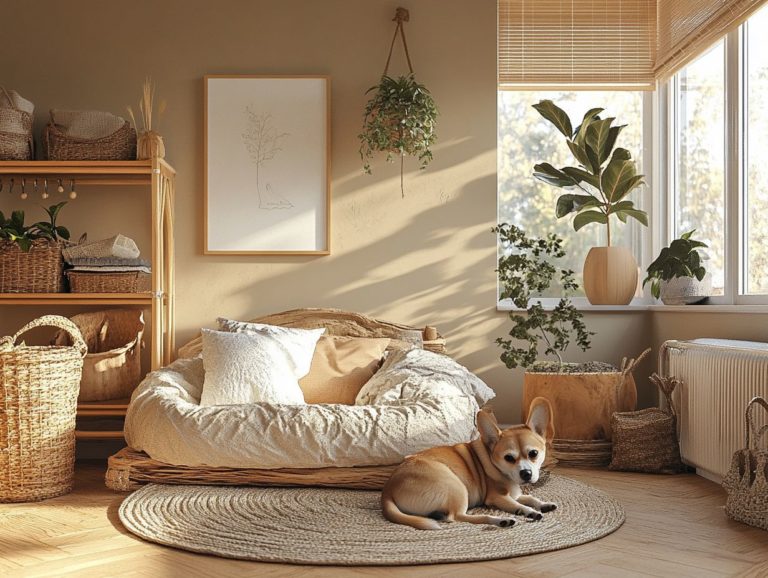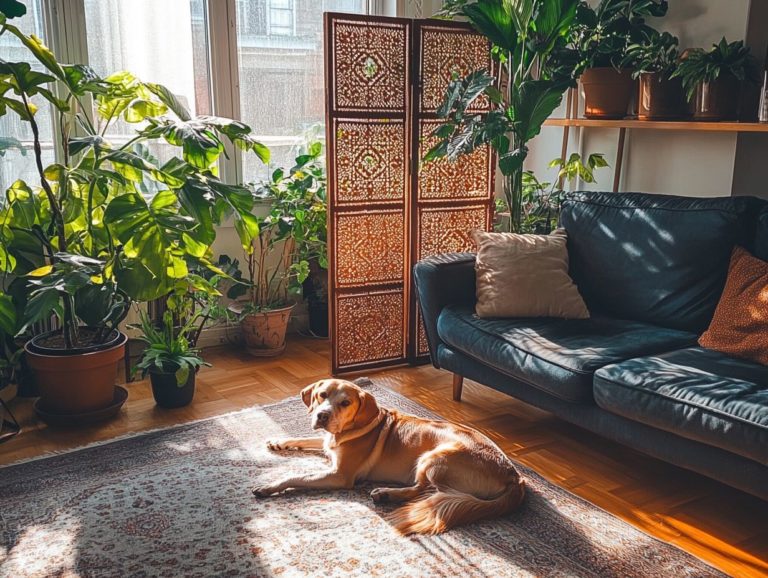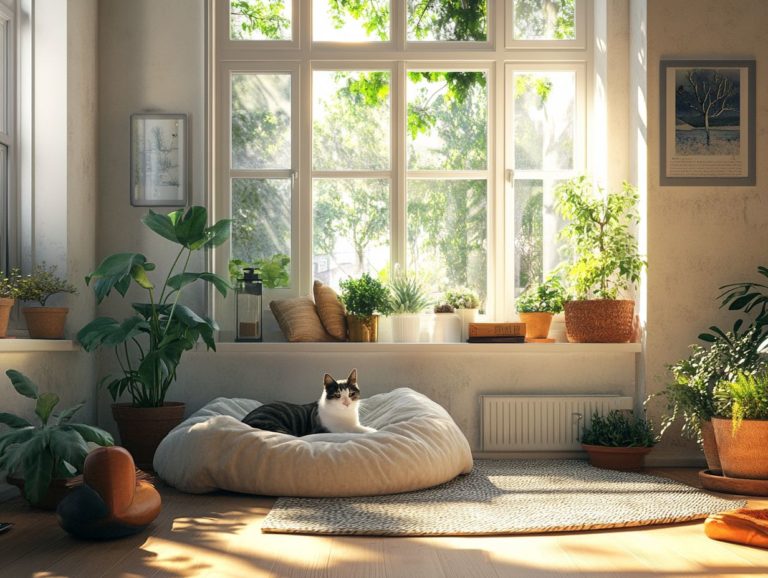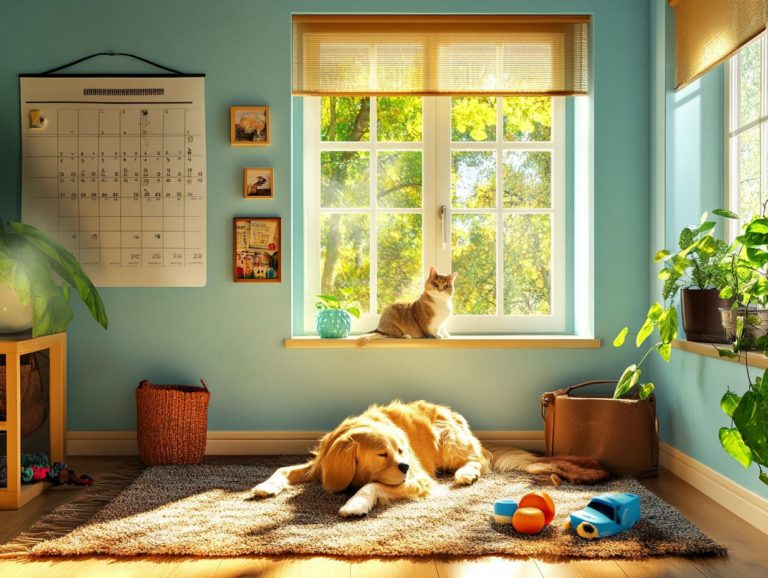How Lighting Affects Pet Anxiety Levels
Creating a serene environment for your furry friends involves more than just setting up cozy corners and comfy beds. It also includes considering effective anxiety management strategies like behavioral training and calming supplements.
The lighting in your home plays a significant role in your pet’s emotional well-being. This piece delves into the often-overlooked connection between lighting and pet anxiety. It reveals how various lighting types, including red light therapy, can influence your pet s mood.
You’ll also discover the signs of anxiety to watch for, such as excessive barking or destructive behavior. Plus, you ll find tips for crafting a calming space and alternative strategies to help your beloved companions feel more at ease.
Contents
- Key Takeaways:
- The Link Between Lighting and Pet Anxiety
- Signs of Pet Anxiety
- How Lighting Can Help Reduce Pet Anxiety
- Creating a Calming Environment for Pets
- Alternative Methods for Reducing Pet Anxiety
- Frequently Asked Questions
- How does lighting affect pet anxiety levels?
- Can different types of lighting affect pet anxiety levels differently?
- How can I use lighting to decrease my pet’s anxiety levels, particularly through therapies like red light therapy and near-infrared light?
- Is there a specific time of day when lighting can have a greater impact on pet anxiety levels?
- Can changing lighting alone completely eliminate pet anxiety?
- Are there any signs that my pet is affected by lighting and experiencing increased anxiety?
Key Takeaways:
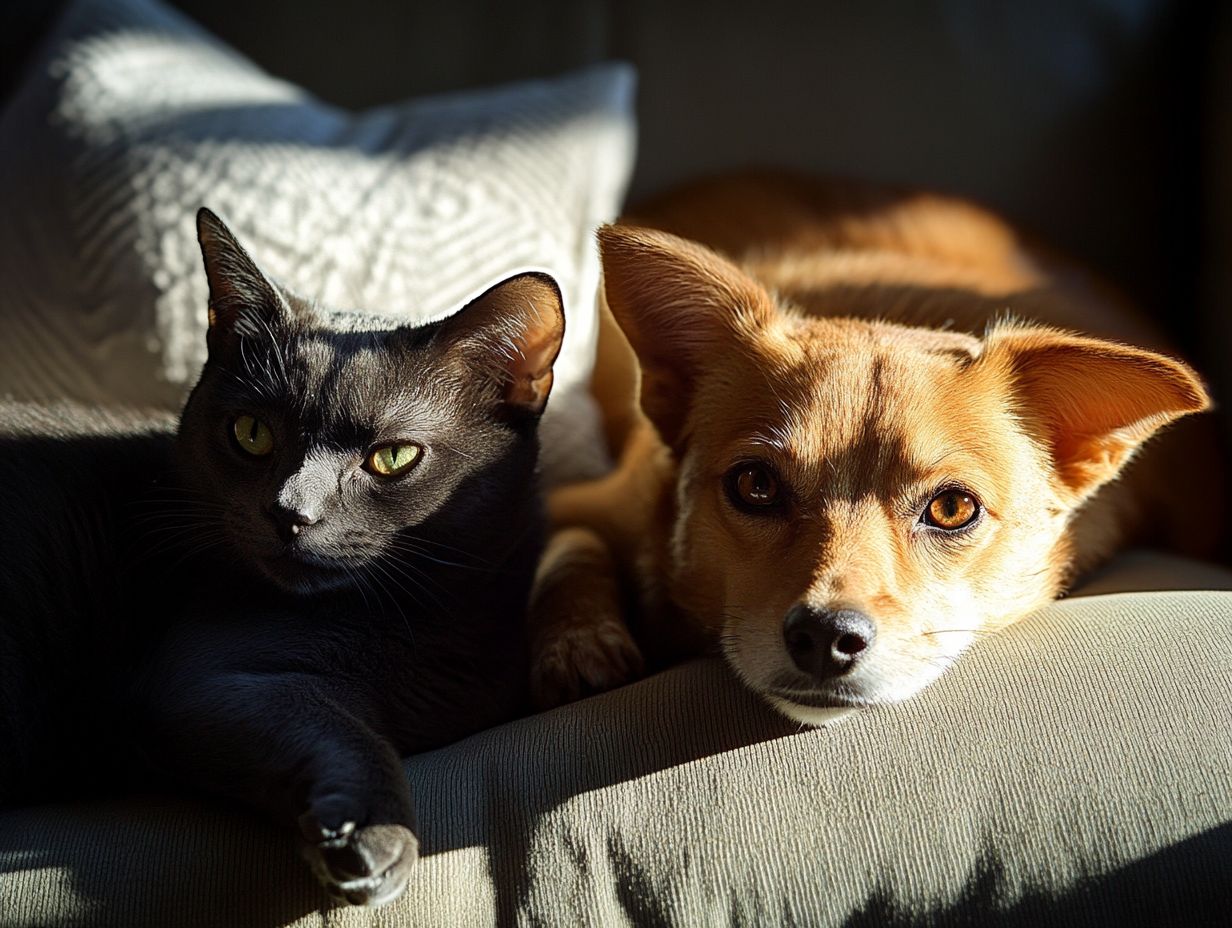
- Proper lighting can play a crucial role in reducing pet anxiety by creating a calming environment.
- Signs of pet anxiety may include changes in behavior and physical symptoms, such as excessive barking or hiding.
- Consider using natural light, dimmed lights, and specialized calming lights to help ease your pet’s anxiety levels.
The Link Between Lighting and Pet Anxiety
Understanding the connection between lighting and pet anxiety is essential for you as a pet owner. Additionally, being aware of the effects of moving on pet anxiety can help alleviate your furry companion’s stress.
Red light therapy, especially through the application of a type of light that isn’t visible but can help, has surfaced as a promising non-invasive treatment for dog anxiety.
This approach offers a calming effect. It can significantly enhance your dog’s overall well-being. By tackling common symptoms of anxiety, it presents a valuable alternative to traditional treatments such as behavioral training and medication.
This opens up exciting new ways to approach your dog s health, benefiting both your dog and you in the process.
Understanding the Connection
The connection between red light therapy and dog anxiety lies in the way the body works. This innovative treatment modality utilizes light wavelengths that penetrate deeply into the skin.
It stimulates cellular processes that promote healing and relaxation. By enhancing circulation and reducing inflammation, it creates a calming atmosphere for dogs grappling with anxiety.
As your pet absorbs these gentle wavelengths, their body produces natural endorphins. This leads to improved mood and decreased stress levels.
Near-infrared light works with mitochondria, the energy-producing structures within cells. It boosts energy and fosters relaxation, which is significant for dogs facing various anxiety triggers.
Signs of Pet Anxiety
Recognizing the signs of pet anxiety is crucial for effective intervention. It helps you identify when your dog is in distress.
Common symptoms can manifest in various ways. These include excessive barking, destructive behavior, trembling, or hiding.
These symptoms often arise in situations involving separation anxiety, noise phobia, or travel anxiety.
Understanding these signs allows you to act quickly and ease your pet s discomfort, ultimately enhancing their overall well-being.
Behavioral and Physical Symptoms

The behavioral and physical symptoms of dog anxiety can vary significantly. This presents challenges for both you and your furry companion.
You may notice these signs manifesting as increased aggression or noticeable withdrawal. These can complicate even the most routine interactions.
An anxious dog might bark excessively a cry for help that can quickly become a source of distress for both of you.
On a physical level, your dog may display symptoms like shaking or panting. These are clear indicators of stress.
Recognizing these symptoms is essential. Elevated cortisol levels triggered by anxiety often cause them.
By addressing these symptoms promptly, you can foster a calmer, more balanced pet. This ultimately enhances the well-being of both your dog and your household.
How Lighting Can Help Reduce Pet Anxiety
Lighting, particularly through gentle red light therapy, can significantly reduce pet anxiety. This treatment utilizes the soothing properties of a specific type of light known for promoting relaxation and alleviating common anxiety symptoms, including the role of natural light in pet comfort.
Incorporating innovative methods into veterinary care elevates treatment quality. You can support your pet’s health in a holistic way.
Types of Lighting to Consider
When exploring lighting options to alleviate pet anxiety, red light therapy truly shines for its proven calming effects and therapeutic benefits, particularly in understanding the effects of age on pet anxiety.
These advanced therapies harness specific wavelengths to soothe nervous pets, fostering relaxation and reducing stress levels. The KOZE X Series and KOZE S Series stand out, crafted to deliver pain relief and comfort through sophisticated light technology.
By emitting soft red light, these devices calm anxious animals and enhance their overall well-being. They aid recovery from injuries, ease discomfort, and increase serotonin levels. Pet owners have witnessed remarkable improvements in their furry companions’ behavior, highlighting how effective the right lighting can be in creating a tranquil environment.
Utilizing such advanced technologies addresses the emotional needs of pets, making a meaningful impact on their daily lives.
Creating a Calming Environment for Pets
Creating a calming environment for your pets is essential for managing dog anxiety. Nurturing a serene atmosphere contributes to their overall well-being.
By implementing strategies like incorporating soothing elements and providing behavioral training, you can significantly alleviate anxiety symptoms. This helps your dogs feel secure and relaxed.
This approach transforms your pet’s life by ensuring both their mental and emotional needs are thoughtfully addressed.
Tips for Managing Anxiety-Inducing Situations
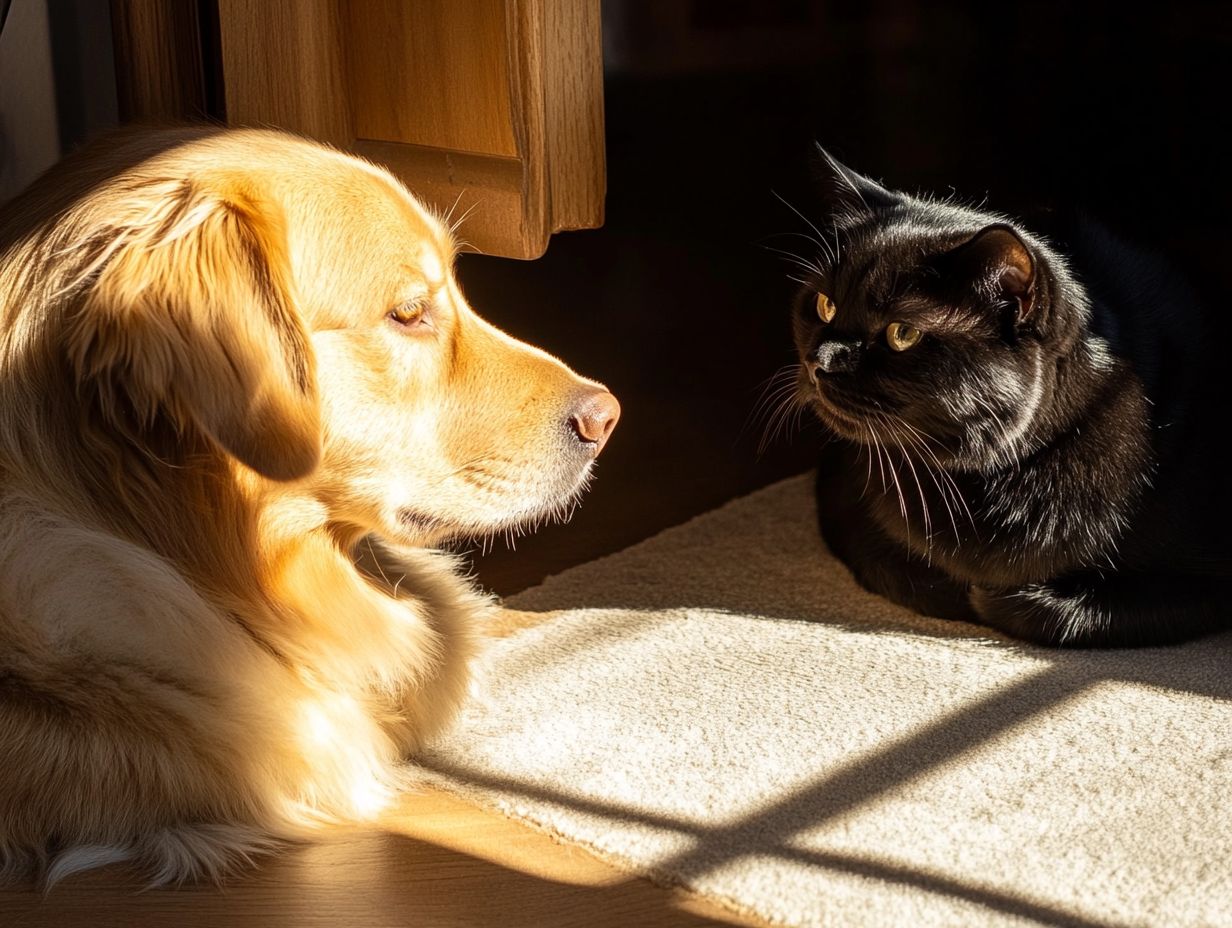
Managing anxiety-inducing situations is crucial for you as a pet owner seeking to alleviate your dog’s anxiety. You want to provide a calming influence during stressful moments.
Take thunderstorms, for example; they can send many dogs into a tizzy, triggering cortisol release and heightening anxiety. It’s important to create a safe haven for your furry friend to retreat to when the skies roar.
Using white noise machines or soft, soothing music can mask unsettling sounds, helping to foster a sense of security. You might also consider behavioral training techniques like desensitization, allowing your dog to gradually become accustomed to storm-related noises in a controlled environment.
If you’re traveling, think about incorporating natural supplements like CBD oil or calming treats. These can make car rides or long flights much easier for your anxious companion.
By blending these strategies, you can adeptly navigate your dog’s anxiety triggers. This ensures a more tranquil experience for both you and your beloved pet.
Alternative Methods for Reducing Pet Anxiety
Exploring alternative methods for reducing your dog’s anxiety can significantly enhance their overall well-being. This provides holistic care that caters to their unique needs.
Beyond red light therapy, consider various approaches like behavioral training, calming supplements, and environmental adjustments.
These diverse strategies enable you to create a personalized plan that effectively addresses your dog’s anxiety symptoms. This fosters a sense of security and comfort in their environment.
Start transforming your pet s anxiety today with these effective strategies!
Other Strategies to Try
Explore various strategies to manage your dog’s anxiety. Creating a calming environment during stressful moments is key.
Behavioral training techniques can be pivotal in helping your dog adapt to situations that make them anxious. Reinforcing positive behaviors and providing reassurance can make a significant difference.
Calming supplements can provide extra comfort. Many pet owners find that natural ingredients like chamomile or valerian root help ease anxiety.
Another effective method is playing classical music. It fosters a soothing atmosphere that reduces stress. By combining these diverse approaches, you can enable your furry friend to navigate moments of anxiety with greater ease.
Frequently Asked Questions
How does lighting affect pet anxiety levels?
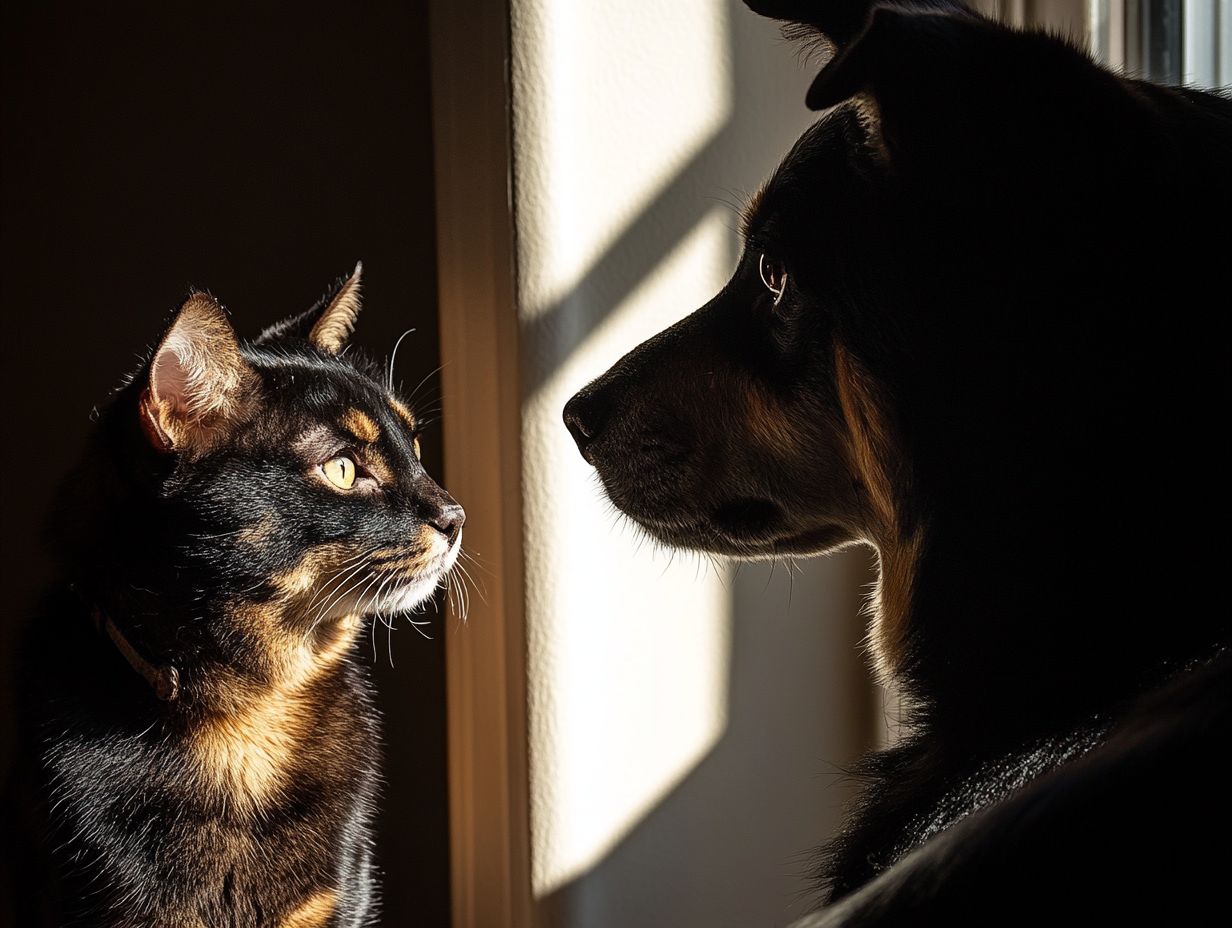
Lighting can significantly impact a pet’s anxiety levels. Studies have shown that bright, fluorescent lighting can cause stress and agitation in animals, while dimmer, warmer lighting, as well as red light therapy, can have a calming effect. Additionally, considering the impact of home décor on pet anxiety can further enhance your pet’s comfort.
Can different types of lighting affect pet anxiety levels differently?
Yes, different types of lighting can have varying effects on pet anxiety levels. Natural lighting is often the most calming for pets, while artificial lighting, such as fluorescent or LED, can be more stressful and anxiety-inducing. For more insights, check out the impact of household items on pet anxiety.
How can I use lighting to decrease my pet’s anxiety levels, particularly through therapies like red light therapy and near-infrared light?
One way to use lighting to decrease pet anxiety levels is by creating a soothing and relaxing environment with warm, dim lighting. For more insights, check out the influence of environment on pet anxiety. Try using natural light from windows or skylights! It works wonders for calming your pets.
Is there a specific time of day when lighting can have a greater impact on pet anxiety levels?
Yes, the time of day can play a role in how lighting affects pet anxiety levels. For example, bright, harsh lighting in the evening can disrupt a pet’s natural sleep and increase anxiety, while softer lighting in the evening can promote relaxation and better sleep. Understanding the impact of shelter life on pet anxiety can also provide valuable insights into creating a calming environment.
Can changing lighting alone completely eliminate pet anxiety?
No, while lighting can play a significant role in pet anxiety levels, it is not the only factor. Other environmental factors, such as outdoor spaces and their impact on pet anxiety, past experiences, and overall health can also contribute to a pet’s anxiety.
Are there any signs that my pet is affected by lighting and experiencing increased anxiety?
Yes, signs that your pet may be experiencing increased anxiety due to lighting include pacing, panting, restlessness, and avoidance of bright or artificial light sources. If you notice these signs, adjusting the lighting in your pet’s environment may help.
Want to learn more about keeping your pet calm? Explore our other resources!

